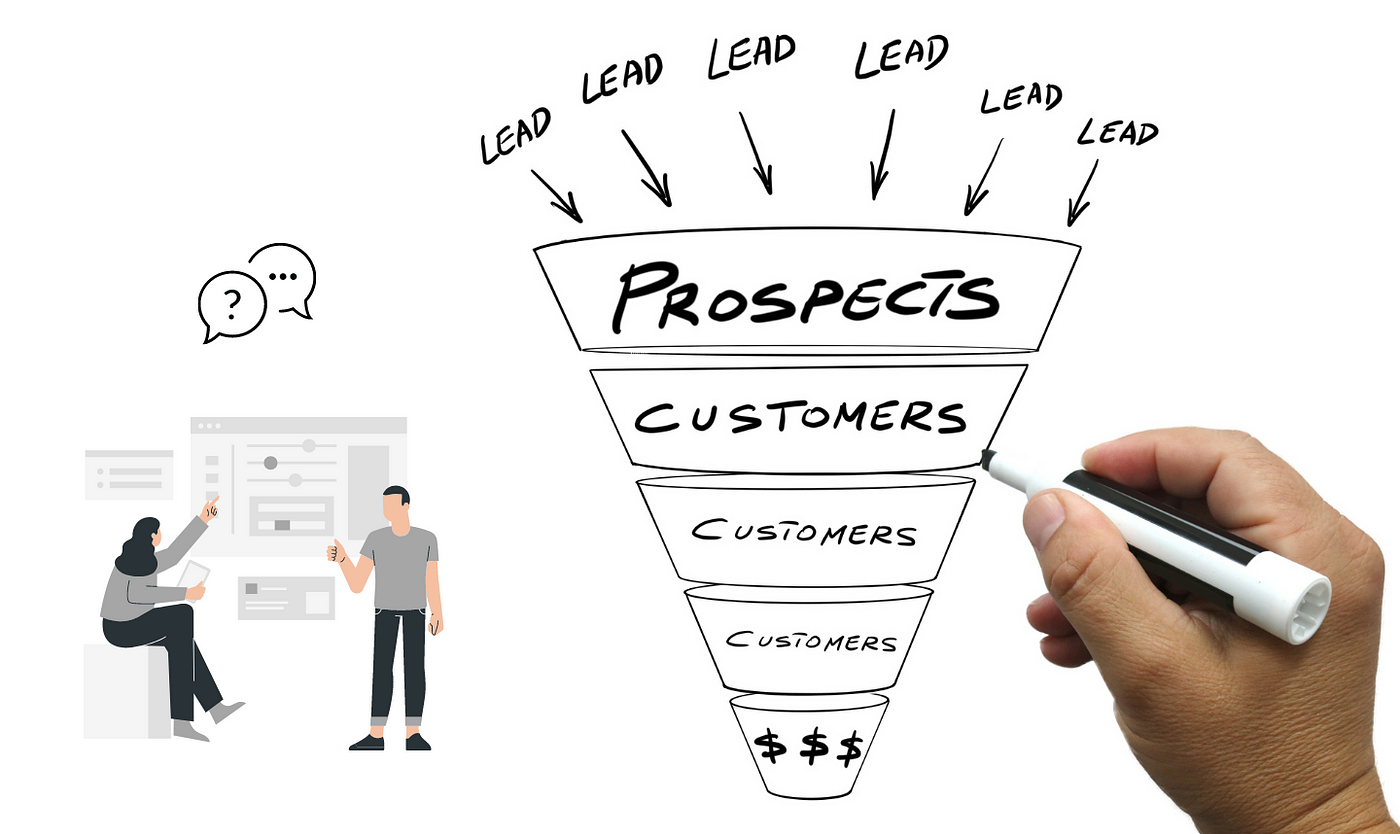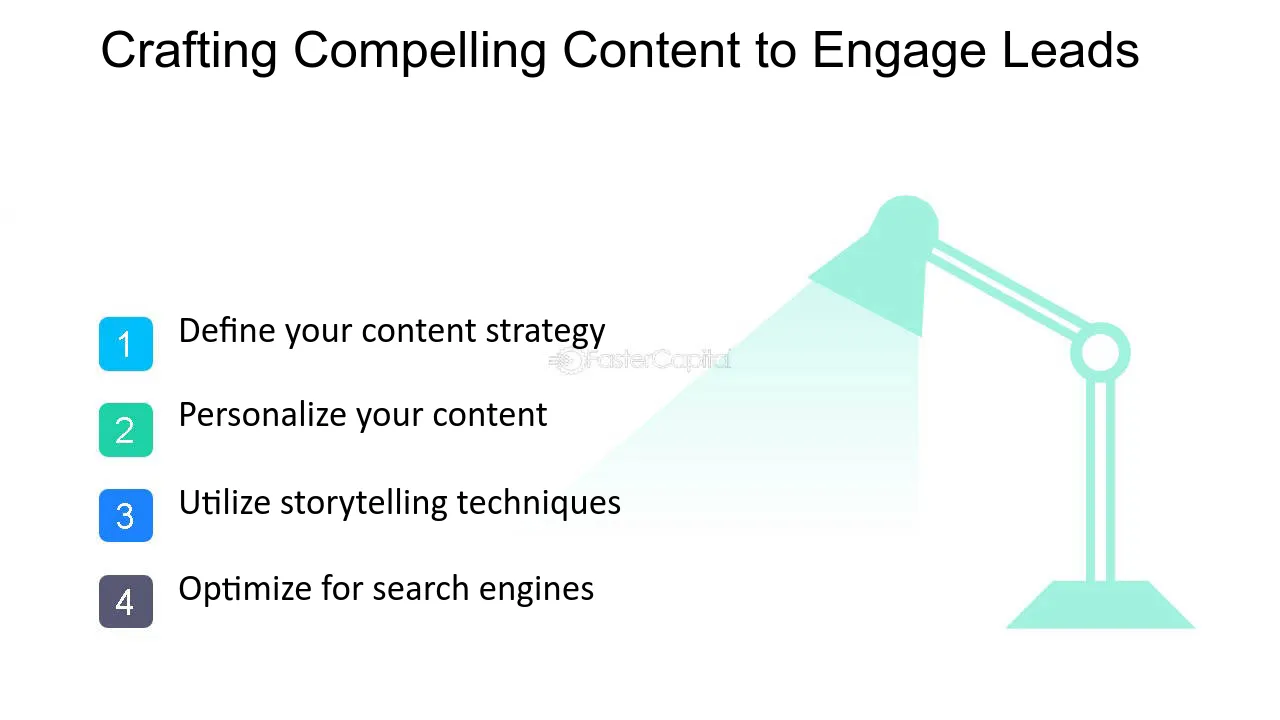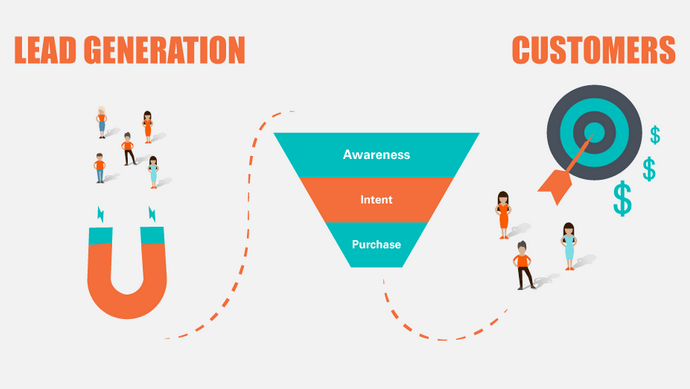Introduction to Lead Conversion: Cultivating Leads into Loyal Customers
The Cornerstone of Business Growth: Understanding the Significance of Lead Conversion
In today’s competitive business landscape, lead conversion stands as a critical pillar for sustainable growth. Imagine your business as a nurturing garden. Leads are the seeds you sow, and lead conversion represents the vital process of transforming those seeds into flourishing plants, ultimately bearing the fruits of loyal customers.
Simply put, lead conversion refers to the process of converting potential customers, also known as leads, into paying customers. These leads can be individuals or businesses who have expressed some form of interest in your products or services, such as by visiting your website, downloading a white paper, or subscribing to your newsletter. However, merely showing interest doesn’t guarantee a sale. Businesses need to nurture these leads and guide them through a well-defined sales process to convert their interest into actual opportunities for business growth.
The Journey from Lead to Opportunity: Navigating the Sales Funnel
The sales funnel, also known as the sales pipeline, visually represents the different stages a lead progresses through before becoming a paying customer. Each stage requires specific actions and strategies to effectively move leads closer to conversion. Here’s a breakdown of the key stages:
- Lead Generation: This stage focuses on attracting potential customers and capturing their information, typically through website forms, social media campaigns, or email marketing.
- Lead Qualification: Not all leads are created equal. This stage involves identifying and qualifying leads that demonstrate genuine interest and possess the necessary characteristics (budget, decision-making power, etc.) to become paying customers. This ensures your sales efforts are concentrated on the most promising leads.
- Lead Nurturing: Once qualified, leads require nurturing to build trust and establish your expertise. This involves providing valuable content, answering questions, and engaging in personalized interactions to keep them engaged and move them further down the sales funnel.
- Opportunity Identification: At this stage, a qualified lead expresses a strong interest in your product or service, presenting a concrete opportunity for conversion.
- Closing the Deal: Through effective communication, negotiation, and addressing concerns, the sales team aims to close the deal and convert the opportunity into a paying customer.
Strategies to Enhance Conversion Rates:
Beyond understanding the stages, various conversion strategies can be applied throughout the lead journey to optimize the process and maximize success:
- Personalized content marketing: Tailor your content and communications to individual needs and interests to resonate with your audience and build stronger connections.
- Automated lead nurturing: Utilize email automation tools for targeted email sequences based on lead behavior and interests, keeping them engaged and moving them closer to conversion.
- Compelling calls to action (CTAs): Craft clear and captivating calls to action that encourage leads to take the next step, whether it’s downloading a brochure, scheduling a demo, or making a purchase.
- Data-driven insights: Leverage customer data and analytics to gain valuable insights into lead behavior, allowing you to refine your strategies and personalize your approach for improved conversion rates.
- Seamless user experience: Ensure a smooth and user-friendly experience across all touchpoints, from your website to your marketing materials, to facilitate lead generation and engagement.
By understanding the significance of lead conversion, the stages of the sales pipeline, and effective strategies, businesses can cultivate leads into valuable customers, fostering sustainable growth and success in the competitive marketplace. In the next section, we will delve deeper into the specific techniques and tactics that can be employed at each stage of the lead conversion process to increase your conversion rates and achieve remarkable results.

Strategies for Effective Lead Management: Cultivating Leads into Loyal Customers
Converting leads into paying customers requires a strategic approach that goes beyond simply capturing their contact details. Effective lead management encompasses a series of tactics aimed at identifying, qualifying, nurturing, and ultimately converting leads into loyal customers. This section dives into specific strategies for each stage of the lead management process.
Identifying and Qualifying Leads: Separating the Wheat from the Chaff
- Identifying Potential Leads:
- Diversify your lead generation channels: Utilize various channels like website forms, social media campaigns, content marketing, and paid advertising to reach a wider audience and attract potential customers.
- Offer valuable incentives: Attract leads by providing valuable content, such as white papers, ebooks, or webinars, in exchange for their contact information.
- Harness the power of referrals: Encourage existing customers to refer their network by offering incentives like referral bonuses or discounts.
- Qualifying Leads: Not All Leads Are Created Equal
- Develop clear qualification criteria: Define specific criteria, such as industry, budget, and decision-making authority, to determine which leads are most likely to convert into paying customers.
- Implement lead scoring: Assign points to leads based on their engagement level, demographics, and behavior, helping you prioritize your sales efforts on high-scoring leads with the best conversion potential.
- Utilize lead qualification forms: Ask specific questions during the lead capture process to gather additional information and assess their fit for your product or service.
Building Relationships through Lead Nurturing: From Seedlings to Blossoming Customers
- Personalize your communications: Tailor your content and communications to individual lead needs and interests. This demonstrates your understanding of their challenges and positions you as a trusted advisor.
- Offer valuable content: Provide informative content such as blog posts, case studies, and white papers that address their pain points and showcase your expertise.
- Engage in multi-channel nurturing: Utilize a combination of email marketing, social media interactions, and personalized phone calls to stay top-of-mind and keep leads engaged throughout their journey.
- Automate nurturing workflows: Leverage marketing automation tools to streamline the nurturing process by sending personalized email sequences based on lead behavior and interests.
- Foster meaningful connections:
- Demonstrate your understanding: Actively listen to their concerns, address their questions, and showcase how your product or service directly benefits them.
- Build trust and credibility: Share testimonials, case studies, and customer success stories to demonstrate the value you deliver and build trust with potential customers.
- Maintain consistent communication: Stay connected with leads through regular, valuable interactions without being overly promotional, fostering a sense of relationship and building long-term loyalty.
Leveraging Data and Analytics: Harnessing the Power of Insights
- Data Analysis:
- Track key performance indicators (KPIs): Monitor metrics like lead generation rates, conversion rates, and customer lifetime value to understand the effectiveness of your lead management efforts.
- Analyze customer behavior: Gain insights into how leads interact with your website, content, and marketing campaigns to identify areas for improvement and personalize the user experience.
- Identify trends and patterns: Leverage data analytics to uncover trends in lead behavior, helping you predict which leads are most likely to convert and allowing you to tailor your strategies accordingly.
- Predictive Modeling:
- Utilize predictive analytics: Leverage machine learning and AI to predict future lead behavior, allowing you to prioritize high-value leads and allocate resources more effectively.
- Personalize lead nurturing based on predictions: Tailor your nurturing efforts based on predicted lead behavior, providing the most relevant content and offers to each lead at the right stage in their journey.
- Anticipate customer needs: By predicting future needs and challenges, you can proactively engage with leads and offer solutions before they even arise, fostering stronger customer relationships.
By employing these effective lead management strategies, businesses can significantly increase their conversion rates, cultivate stronger customer relationships, and achieve sustainable growth. In the next section, we will explore the crucial role of sales automation in streamlining the lead conversion process and boosting efficiency.
Engaging Leads with Compelling Content: Nurturing Leads through the Customer Journey

In the dynamic landscape of lead conversion, compelling content plays a pivotal role in engaging leads and nurturing them through the sales funnel. This section explores various strategies for crafting captivating content, utilizing diverse marketing channels, and personalizing the customer journey to build trust and drive conversions.
Crafting Relevant and Valuable Content: Building Credibility and Trust
The foundation of successful lead engagement lies in creating relevant and valuable content that resonates with your target audience’s specific needs and interests. This content should serve two primary purposes:
- Establishing Credibility and Thought Leadership:
- Share your expertise: Offer insightful blog posts, white papers, and case studies that showcase your industry knowledge and demonstrate how your product or service addresses real-world challenges.
- Become a trusted resource: Position yourself as a valuable source of information by providing educational content that tackles common industry problems and offers practical solutions.
- Leverage data and research: Include data-driven insights and industry research findings to add credibility and authority to your content, demonstrating your commitment to evidence-based solutions.
- Addressing Lead Needs and Interests:
- Conduct audience research: Gain a deeper understanding of your target audience’s pain points, preferences, and preferred content formats through surveys, social media listening, and customer feedback.
- Tailor content to different stages of the buying journey: Offer awareness-stage content like blog posts and infographics, while providing more in-depth content like white papers and case studies for consideration-stage leads.
- Variety is key: Utilize diverse content formats like videos, infographics, and interactive elements to cater to different learning styles and preferences, ensuring your content is engaging and accessible.
Implementing Multi-channel Marketing: Reaching Leads on Their Preferred Platforms
In today’s digital world, omnichannel marketing is crucial for reaching leads across the various touch points they frequent. This involves utilizing a combination of marketing channels to deliver targeted messaging and ensure consistent brand presence throughout the customer journey. Some key channels to consider include:
- Email Marketing: Utilize email campaigns to nurture leads with personalized content, offer valuable resources, and nurture relationships.
- Social Media Engagement: Actively participate on relevant social media platforms to share content, engage in conversations, and build a community around your brand.
- Website Optimization: Ensure your website is user-friendly, informative, and optimized for search engines, guiding leads towards valuable content and clear calls to action.
- Paid Advertising: Strategically utilize paid advertising platforms like Google Ads and social media advertising to reach targeted audiences and amplify your content reach.
By employing a multi-channel marketing approach, you can ensure your content reaches leads at various touchpoints, maximizing their exposure to your brand and increasing engagement throughout their buying journey.
Personalizing the Customer Journey: Creating Tailored Experiences
Personalization is no longer a luxury; it’s a necessity for engaging leads and driving conversions in today’s competitive landscape. By tailoring the customer journey based on individual preferences and behaviors, you can create a more meaningful and relevant experience, leading to increased engagement and conversion rates. Here are some ways to personalize the customer journey:
- Segment your audience: Divide your leads into groups based on shared characteristics, demographics, or interests, allowing you to deliver content and messaging that resonates with each segment.
- Dynamic content personalization: Leverage marketing automation tools to personalize website content, emails, and landing pages based on individual lead behavior, interests, and browsing history.
- Utilize lead scoring: Assign scores to leads based on their engagement level and behavior, allowing you to prioritize high-scoring leads with personalized outreach efforts.
By consistently creating valuable content, utilizing diverse marketing channels, and personalizing the customer journey, businesses can foster deeper connections with leads, establish trust, and ultimately cultivate them into loyal customers. In the next section, we will delve into the importance of data security in lead management and explore strategies to ensure your valuable customer data is protected.
Converting Leads into Opportunities: Cultivating Interest into Action
Having nurtured leads with valuable content and fostered meaningful connections, it’s time to convert their interest into concrete opportunities. This section explores effective sales techniques, strategies for handling objections, and the power of compelling offers to push leads towards the final conversion stage.

Effective Sales Techniques: Communicating Value and Sealing the Deal
- Consultative Selling:
- Shift the focus to understanding needs: Move beyond simply presenting your product or service. Instead, actively listen to understand the lead’s unique challenges, pain points, and desired outcomes.
- Position yourself as a trusted advisor: Leverage your expertise to help them diagnose their problems and showcase how your solution specifically addresses their needs.
- Focus on the value proposition: Clearly articulate the tangible benefits of your product or service and how it directly contributes to solving their problems and achieving their desired goals.
- Building Trust and Rapport:
- Demonstrate genuine interest: Actively listen, ask open-ended questions, and show genuine care for their concerns. This fosters a connection and builds trust, which is crucial for successful conversion.
- Maintain clear and transparent communication: Provide accurate information, avoid making exaggerated claims, and address any concerns with honesty and transparency.
- Demonstrate empathy and understanding: Acknowledge their challenges and validate their concerns, showcasing your commitment to finding solutions that truly benefit them.
- Effective Communication Strategies:
- Tailor your communication style: Adapt your communication style to match the lead’s preferred approach, whether it’s direct and concise or more detailed and consultative.
- Use powerful storytelling: Share compelling stories, case studies, and customer testimonials to bring your message to life and demonstrate the impact your solution can have.
- Focus on benefits, not features: Explain how your features translate into tangible benefits for the customer, emphasizing how your product or service will improve their life or business.
Handling Objections and Overcoming Barriers: Addressing Concerns for Smooth Conversion
It’s natural for leads to have questions and concerns throughout the sales process. Addressing these objections effectively is key to overcoming barriers and moving them closer to conversion. Here’s how:
- Actively listen and acknowledge their concerns: Don’t interrupt or dismiss their objections. Instead, listen carefully, acknowledge their perspective, and demonstrate empathy.
- Clarify the objection: Ask clarifying questions to fully understand the root cause of the objection. This helps you tailor your response to address their specific concerns.
- Offer solutions, not just answers: Don’t simply provide explanations; offer specific solutions and concrete examples of how your product or service can overcome their objections and alleviate their concerns.
- Be prepared with common objections: Anticipate common objections and practice your responses beforehand. This allows you to deliver confident and informative answers.
Creating Compelling Offers and Incentives: The Tipping Point for Action
While not the sole factor in converting leads, strategically crafted offers and incentives can act as the final nudge towards conversion. Here are ways to create compelling offers:
- Limited-time offers: Create a sense of urgency by offering a discount or bonus available for a limited time, encouraging immediate action.
- Tailored offers: Personalize your offer based on the lead’s unique needs and budget, making it more relevant and appealing to them.
- Value-added services: Include additional benefits like free consultations, extended warranties, or training sessions to enhance the value proposition and make your offer more attractive.
- Clear terms and conditions: Ensure your offer terms and conditions are transparent and easy to understand, avoiding any confusion or potential disappointment after accepting the offer.
By implementing these sales techniques, effectively handling objections, and leveraging compelling offers, businesses can successfully convert nurtured leads into opportunities, ultimately driving sales and achieving desired growth objectives. In the next section, we will explore the role of customer relationship management (CRM) in streamlining the lead conversion process and fostering long-term customer success.
Measurement and Optimization: Cultivating Continuous Improvement

Converting leads into loyal customers is an ongoing process that requires continuous monitoring, evaluation, and optimization. This section explores the importance of tracking and analyzing conversion metrics and implementing iterative improvement strategies to ensure your lead conversion efforts yield the best possible results.
Tracking and Analyzing Conversion Metrics: Measuring Success and Identifying Gaps
- Key Performance Indicators (KPIs):
- Lead generation rate: Measures the effectiveness of your lead generation efforts and helps identify potential areas for improvement.
- Lead conversion rate: Tracks the percentage of leads who convert into paying customers, providing a crucial indicator of the overall effectiveness of your lead management process.
- Sales cycle length: Measures the average time it takes to convert a lead into a customer, helping you identify potential bottlenecks and streamline the sales process.
- Customer lifetime value (CLTV): Measures the total revenue a customer generates over their relationship with the company, highlighting the importance of customer retention.
- Data Analysis and Insights:
- Leverage reporting tools: Utilize analytics dashboards and reports to visualize key metrics, identify trends, and gain valuable insights into lead behavior and conversion patterns.
- Identify areas for improvement: Analyze results to pinpoint weaknesses in your lead management and sales processes, allowing you to prioritize improvement efforts.
- Benchmark against industry standards: Compare your metrics against industry benchmarks to understand your position and identify areas where you can surpass your competitors.
Iterative Improvement and Testing: A Continuous Cycle of Optimization
- Embrace an A/B testing approach:
- A/B testing involves comparing two versions of a webpage, email, or marketing campaign to see which one performs better. This allows you to data-driven decisions and optimize your lead conversion strategies.
- Test different elements: Experiment with various aspects of your lead conversion process, such as website landing pages, email subject lines, and call-to-action buttons, to identify the most effective combinations.
- Continuously refine your approach: Based on your test results, continually iterate and improve your lead conversion tactics over time, ensuring you remain at the forefront of ever-evolving marketing and sales best practices.
By tracking and analyzing key metrics alongside embracing iterative improvement and testing, businesses can gain valuable insights, refine their lead conversion strategies, and continuously optimize their approach to achieve long-term success in today’s dynamic marketplace.
Conclusion
In conclusion, mastering the art of lead conversion is paramount for sustained business growth and success. The journey from identifying potential leads to converting them into opportunities is a dynamic process that requires strategic planning, effective communication, and continuous optimization. By implementing robust lead management strategies, businesses can nurture relationships, provide valuable content, and employ compelling sales techniques to guide leads through the conversion funnel.
The importance of data-driven decision-making cannot be overstated. Regularly tracking and analyzing conversion metrics enables businesses to gain insights into the effectiveness of their strategies, identify areas for improvement, and make informed adjustments. Iterative testing and optimization, including A/B testing and continuous improvement initiatives, play a pivotal role in refining approaches and maximizing conversion rates over time.
As businesses navigate the evolving landscape of customer expectations and market dynamics, personalized engagement and tailored experiences become indispensable. Crafting relevant content, implementing multi-channel marketing efforts, and personalizing the customer journey contribute to building meaningful connections with leads.
The journey doesn’t end with successful conversions; it extends to measuring success and planning for future growth. Businesses should celebrate achievements, learn from challenges, and stay adaptable to emerging trends and opportunities. Ultimately, a commitment to mastering lead conversion not only drives immediate business growth but also lays the foundation for sustainable success in the competitive marketplace.
Embrace the power of effective lead conversion, continuously refine strategies, and unlock the full potential of opportunities for your business’s prosperity and longevity. As the business landscape evolves, so too should your approach to lead conversion, ensuring a resilient and forward-thinking foundation for sustained growth.









